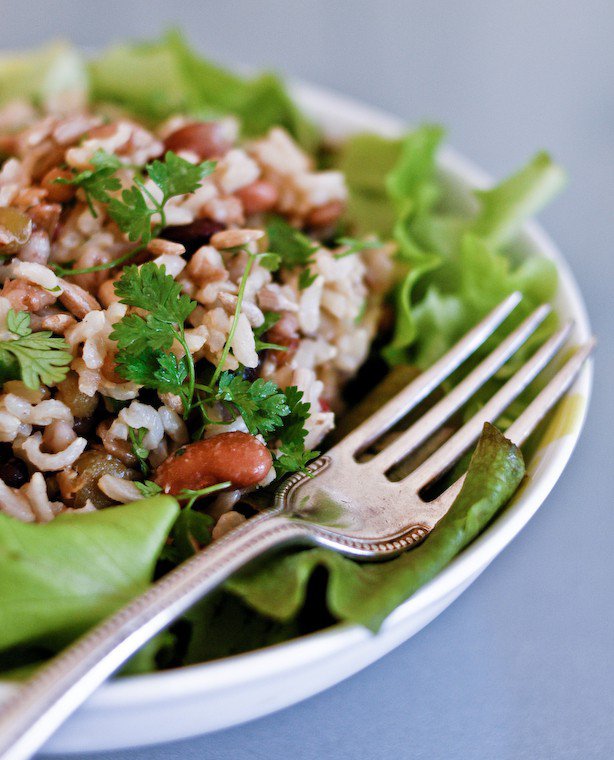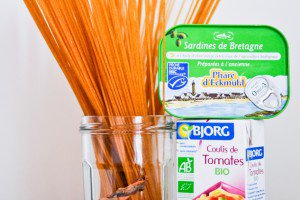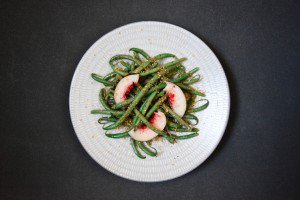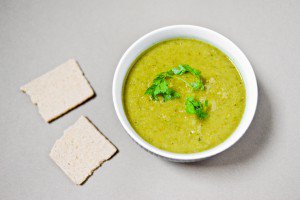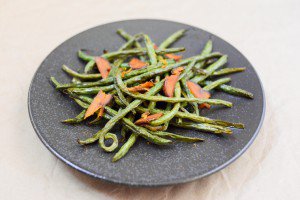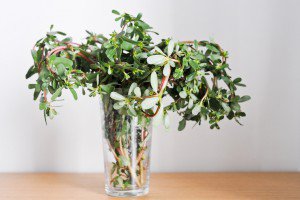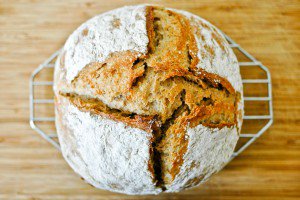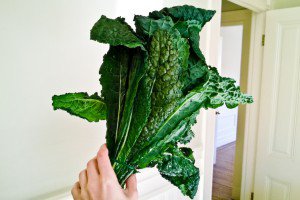I hardly ever eat meat or fish when I’m alone. I may have a bit of ham or chicken on occasion if there is some left over from another meal, but other than that, my solo appetite favors a plant-based diet, with a few dairy products (yogurt, cheese) and eggs thrown in.
And because I eat most of my weekday lunches at home, in my own company (I admit I’ve become frightfully attached to the quiet and solitude of my workdays) and as an accidental vegetarian, I started to worry about protein: was I getting enough?
It’s hard to say, since I’m not so worried as to weigh my food and tally up the grams of protein, but I thought it couldn’t hurt to be a little more diligent about my grain-and-legume combos, as in this rice and bean salad.
Getting enough protein from a vegetarian lunch bowl
A quick reminder to those of you who don’t spend their lives reading nutrition articles: most animal products provide what’s called complete proteins, meaning they contain optimal proportions of all the essential amino acids (= the smaller units that constitute proteins) the human body can’t manufacture, and therefore needs to obtain from its diet. Plant products, on the other hand, don’t provide that same balance in essential amino acids, offering good amounts of some and low amounts of others. But as Mother Nature would have it, the amino acids found in grains and those found in legumes are complementary*, so that combining the two essentially results in a complete protein. Ha!
You don’t have to eat the two at the same time — you could eat a grain at one meal and a legume at the next, as the amino acids are said to remain available for a possible hookup for twelve hours — but they happen to go really well together, as illustrated in many culinary cultures**: think couscous and chickpeas, pita and hummus, baked beans on toast, rice and lentils, corn and beans, rice and beans, pasta and beans…
Batch-cooking for easy lunches
And so I resolved to cook a batch of some type of grain and some sort of legume at the beginning of every other week or so, and incorporate it into my lunches on subsequent days. It’s also a big time saver, naturally, because a minimal effort on Monday promises near-instant lunches after that: all I need to do then is add a form of fresh vegetable to the mix, raw or cooked, and we’re in business.
Today’s rice and bean salad is an example of one such preparation: it uses a mix of beans and other legumes I bought on sale at the organic store — it was marketed as a soup helper — and an organic, fair-trade brown rice from Thailand I really like (it is fragrant and not too chewy, and it cooks quickly). The legumes and rice are soaked and cooked separately, then tossed with fresh herbs (chervil, in this case) and a mustardy vinaigrette.
I eat it slightly warm the first day, then cold or at room temperature. It works well over a bed of mixed greens, as a wrap in lettuce leaves or rice paper, plopped in a bowl of soup, or “refried” in a skillet and eaten in a tortilla. In all cases, it is wonderfully filling, improves as it sits, and can be easily transported for lunch at the office, where I hope you’re able to find a little quiet and solitude from time to time.
~~~
* You can get similar results by combining seeds, nuts, and protein-rich vegetables (such as leafy greens or broccoli) with grains and/or legumes.
** I thought about this for a while, but couldn’t find a good grain-and-legume example in the French culinary repertoire, apart from a lentil soup one might eat with bread. Can you think of examples yourself? Update: A reader pointed out that the provençal soupe au pistou is an example, involving beans and pasta. Thanks Anaïk!

Have you tried this? Share your pics on Instagram!
Please tag your pictures with #cnzrecipes. I'll share my favorites!
Ingredients
- 240 ml (1 cup) mixed dried beans and legumes (my mix includes borlotti beans, kidney beans, tiny black beans, adzuki beans, split peas, red and green lentils, and chickpeas)
- 240 ml (1 cup) brown rice
- A 3-cm (1-inch) piece of dehydrated kombu seaweed (see note below)
- 1 tablespoon balsamic vinegar (not the real kind sold at the price of platinum in teeny bottles, but a decent one nonetheless)
- 1 teaspoon lemon juice
- 1 rounded teaspoon strong mustard
- Tabasco sauce
- 2 tablespoons good olive oil (or the good oil of your choice; you can use a little hazelnut or sesame or walnut oil in there, too)
- A small bunch chervil or flat-leaf parsley or cilantro, roughly chopped
- Sea salt
- Freshly ground black pepper
- Mixed greens for serving
Instructions
- Soak the beans in a large bowl of cold water for 12 hours, or up to a day.
- A little while before cooking, soak the rice: rinse in fresh water, drain well, and put in a medium saucepan. Add the volume of water recommended on the package -- mine says to use double the volume of water, but I use a little less (1 4/5 cups rather than 2 cups) because I like the texture better that way -- and let the rice soak in the water for 20 minutes to 1 hour.
- Rinse the soaked beans in fresh water and put them in another medium saucepan with the kombu. Cover with cold water (no salt) by about 2 cm (1 inch), cover, and bring to a simmer. As the water comes to a simmer, a white foam will collect at the surface; skim and discard it.
- Cook the beans at a low simmer for 1 hour, or until the beans are just cooked through: you want them to retain their shape, and not turn to mush. Drain, remove the seaweed, and let cool slightly.
- While the beans are cooking, get the rice started. Add 1/4 teaspoon salt to the pan, cover, bring to a simmer, then lower the heat and cook at a low simmer, without disturbing, until all the water is absorbed -- this will take anywhere from 12 to 40 minutes, depending on your particular type of rice. Remove from the heat and let rest for 10 minutes, then uncover and let cool slightly.
- In a large salad bowl, combine the vinegar, lemon juice, mustard, 1/4 teaspoon salt, and Tabasco sauce and pepper to taste. Add the oil slowly, stirring to blend and form an emulsion.
- Add the beans and fold them in gently with a spatula; you want to coat them with the dressing without mushing. Fluff the rice with a fork (to separate the grains) and add it in along with the herbs -- again, using a gentle hand. Taste, correct the seasoning and (probably more important) the acidity of the dressing, and serve in shallow bowls, on a bed of mixed greens.
- Leftovers should be placed promptly in an airtight container in the fridge, and eaten over the next 2 days. They can also be frozen.
Notes
Kombu (or kelp) is a seaweed that comes in black strips; look for dehydrated kombu at natural food stores and Japanese markets. Adding it to the cooking water for beans enhances their flavor, and makes them more tender and easier to digest.
This post was first published in March 2010 and updated in January 2016.


